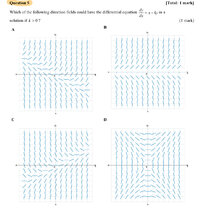
Why is it that option C is correct but not A. C is A reflected across the y axis. A would be valid if the value of k is such that the magnitude of ky is less than x. Hence in quadrant 1 and 2, there are mostly positive slopes, and in quadrant 3 and 4, there are mostly negative slopes. C is also valid but if the value of ky is such that the magnitude is more than x, resulting in mostly negative slopes in Q1,2 and mostly positive in Q3,4.
